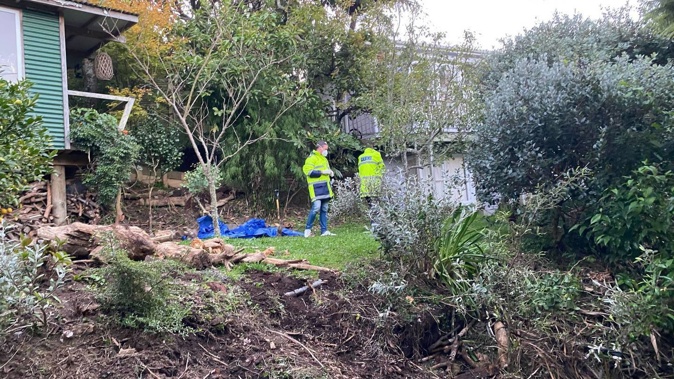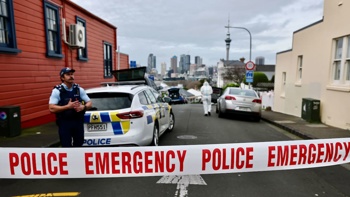
For years, a mystery has lain buried in the backyard of a suburban Wellington home.
Barely a foot deep, close enough to the surface that the unwitting homeowner was able to stumble across it while tending the garden on a quiet April weekend.
The Herald can now reveal the truth behind the 100-year-old human skull and jawbone unearthed in Wadestown.
"There is no evidence of unexplained trauma or injury to the skull, nor does it show signs of decapitation at or proximate to the time of death," Detective Sergeant James Stewart said.
"A former occupant of the address has described discarding the skull in the garden at the address some years ago. The investigation team have spoken with a number of witnesses and traced the origin of the skull as far back as a century.
"The skull was described by witnesses as a medical specimen, and forensic examination by the ESR corroborates this."
It's a theory that had already been floated by more than one expert spoken to by the Herald.
Wellington City Libraries historian Gábor Tóth had earlier said it was possible the skull was an old medical sample or teaching specimen, like the old skeletons that used to be kept in school classrooms.
According to forensic anthropologist Dr Angela Clark, bones buried within the past 100 years or so are difficult to date because of atomic bomb testing in the 1900s. The effect of the nuclear weapon testing on the atmosphere means radiocarbon dating for recent remains is "useless".
"It's an interesting concept to figure out how long a bone's been in the ground, there's so many variables," she said.
Without the ability to carbon date the skull, the clues to the age of the skull lie with the context in which it was buried.
"There might be other artifacts that were buried around the same time."
The skull might also have indicators that showed whether the person was Polynesian or Caucasian, which could also help narrow the timeframe.
Clark said if there were no other bones found in the area, it was likely only the head or skull was buried, as bones "don't just disappear".
In her line of work, she had members of the public bringing in skulls they had found while clearing out the attic or office of a deceased family member. Often, they came from dentist offices and the like.
"We get those handed in to us and we keep them when they can't be obviously looked after by normal members of the public."
In this case, it was possible somebody had the skull and didn't know what to do with it, so decided to bury it.
"It doesn't necessarily have to have a sinister motive."
Bioarcheologist Dr Rebecca Kinaston said it would be "really hard" to narrow down the age of the skull without finding materials buried around it.
She noted if an expert had been involved in digging up the area it was found, they may have been able to determine more based on the soil disturbance and the skull's proximity to other materials.
"If you're excavating carefully you'll be able to tell the size of the hole that's dug," she said.
Another useful indicator of age was whether the skull had any relatively modern dental work done on it.
Marks on the bones could also help determine if the person was subjected to any physical trauma.
Tóth said it was "extremely unusual" for anyone to be burying bodies in their back yard 100 years ago.
"It wasn't something that's done, it's against the law, has always been and remains so."
A special piece of legislation had to be passed for each burial outside a cemetery, and he only knew of a handful in Wellington that had been allowed.
All of those burial spots were marked with some type of memorial, he said.
They include the Tomb of the Unknown Warrior at the National War Memorial, and former Prime Minister William Massey at Point Halswell.
"It's a very rare occurrence that only really happens when the person is of great significance."
Manager of Archaeology at Heritage New Zealand Vanessa Tanner said they were contacted by police about the discovery, but because the skull appeared to be buried within the 1900s it was not within their remit.
"If it's pre-1900s then Heritage NZ works with tangata whenua and land owners to manage what needs to occur," she said.
"Often the human remains will be in an archaeological context and that will enable us to determine whether or not it's pre-1900."
The homeowner, who did not want to be named, said they had not been updated by police on the investigation but "it's a relief that it doesn't appear to be, at least, a recent tragedy".
They said finding the skull was "certainly surprising".
"It doesn't happen every day."
At the time of the discover, a neighbour told the Herald the area where the skull was found had been undisturbed for quite some time, but recently there'd been some developments and tree-felling.
"I was joking it's a cold case because that area had been undisturbed for a long time," she said. "It's a bit spooky down there."
Wadestown is one of the oldest suburbs in Wellington, and the woman says the remains could have been in the garden for years. But a lot of rubbish gets thrown down the side of the gully so it could also be that, she theorised.
"It's definitely kind of weird but quite exciting really," she said. "Things aren't very exciting around here – it's very boring and suburban."
Wadestown, which has a population of just under 4000 residents, was considered Wellington's first suburb after it was settled by auctioneer John Wade in 1841. The majority of houses in the area were constructed in the 1920s. The median sales price for homes in the area these days is $1.88 million, according to OneRoof.co.nz.
The street where the remains were found is considered one of the steepest in the region, according to the Encyclopedia of New Zealand.
- by Melissa Nightingale, NZ Herald
Take your Radio, Podcasts and Music with you









